Interviewsand Articles
The Temples of Angkor Wat and the Search for Meaning in Life
by Richard Smithies © 2020, May 12, 2020

first published anonymously in Material for Thought, Far West Press, Spring 1974.
In the Brihad-Aranyaka Upanishad, there is a prayer that could have been written at any time, by any man of any religion:
From the unreal, lead me to the real!
From darkness, lead me to light!
From death, lead me to immortality!
The wish expressed in this prayer lies behind my interest in the symbolism of the ruined temples of Angkor. During the years since I visited Cambodia in 1967, 1 have noticed a gradual change in my understanding of what I observed there and in what I find of most interest in my photographs. Initially I was excited at having visited a "lost city" and awed by the magnificence of the architecture. But as I learnt more about the history of the Khmers, this first flush of excitement was replaced by a growing interest in the causes of the rise and decline of such a great civilization. Later, I became increasingly aware that the symbolism employed by the Khmers in their religious buildings was strikingly similar to that of other ancient cultures throughout the world.
The symbolism portrayed in the temples of Angkor is religious, and by that I mean that it relates to man's search for reality, light and immortality. But nothing I read then about Angkor and its symbols seemed more than academic interpretations which failed to come together as a living whole that related to the reality of life. The master builders of Angkor hardly went to so much trouble to convey so little. For a long time I lived with the tantalizing feeling that the most important element was missing. Only when I tried to write down what I understood did I realize that it was my own experience that was missing. The symbolism of Angkor was directly related to my own search for meaning, for reality in life.
I have dwelt on this process of change in interest and understanding because it has taught me two important lessons concerning symbolism and its use in religion. The first lesson is that such symbolism can be understood on different levels and in different ways at different times by the same person. It is not the symbols that change, but a person's ability to see what they convey. The second lesson is that a whole or living meaning of a symbol cannot be found by piecing together different interpretations. For a symbol to be understood as a living whole, as a unity, there must be a corresponding search for unity within the man who attempts to search for a meaning. In short, the search for meaning in outward religious symbols must mirror the inner spiritual search. For such symbols to be real, and not merely intellectual fantasies, they must have relevance to life and its meaning and they must be studied as an organic whole.
Religious symbols are keys that can help unlock the doors that separate us from a meaningful contact with life. But the desire to look for such keys can only stem from a deep-felt need to find out what life is all about. If a man tries to observe himself, he will find the right keys to open new doors at the right time. Because this is such a personal matter, no other person can give him the key. It has to be his own discovery. A pupil once observed to the Sufi teacher, Bahaudin Naqshband, “You relate stories, but you do not tell us how to understand them.” Bahaudin replied: “How would you like it if the man from whom you bought the fruit consumed it before your eyes, leaving you only the skin?”
THE SEVEN KEYS OF ANGKOR
Angkor emerged in the 9th century as the capital of the Kingdom of Kambuja, as Cambodia was then known. Cambodia was strategically placed astride the monsoon sea route to China and it was the trade between India and China at that time which led to the introduction of Hinduism and Buddhism to southeast Asia. The Khmer culture, which found its most perfect expression in Angkor, grew from the fruitful exposure of the indigenous Mon-Khmer peoples of the region to religious, cultural and commercial influences from India.
Angkor has been called a “lost city”. Following invasions from Thailand and by the Chams from Vietnam, Angkor was abandoned to the jungle in the middle of the 15th century and it was not until four centuries later that the former capital of the Khmers was “rediscovered.” 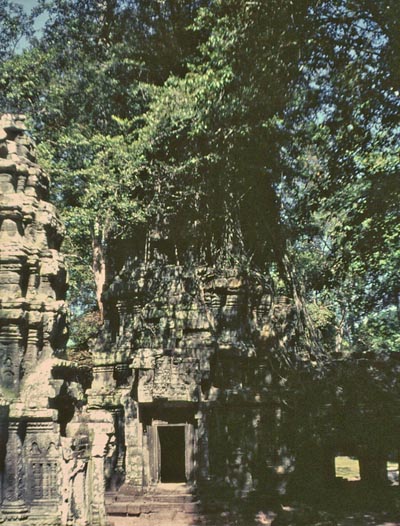
During these years, the jungle overran Angkor and destroyed all that was not built of stone. In so doing the jungle purified Angkor, for only the monuments, walls, gates and temples built of stone survived and stone was only used in constructions having a religious significance that related to the eternal. Whatever was merely of passing or temporal significance was built of perishable materials. Today, all vestiges of the temporal have vanished, leaving the stone ruins alone to testify to the city's greatest function, which is to serve as a framework and a guide to help individual men in their search for meaning in life.
The ruins of Angkor contain the keys necessary to understand the help or teaching concerning the meaning of life that was available to the Khmers one thousand years ago. While the form of the teaching was profoundly marked by the country's links with India it was also rooted in the common experience of man, irrespective of time, place or culture. The substance of this teaching is transmitted in the form of symbols or keys, which may be either visual analogies or oral allegories, such as parables and myths. Both forms are to be found in the conception, design, materials and ornamentation of the sacred city and of the temples of Angkor.
In ancient Egypt, another civilization in which architecture was used to teach, the root of the word for “door” was the same as that for “teaching”. The question that is the theme running through this essay is can the keys inherited from ancient civilizations be used to open the door to understanding the meaning of life? We shall discuss seven of the keys of Angkor: the snake, the bird, the five towers, the stepped pyramid, the seven steps, the world axis and the legend of the churning of the sea of milk.
THE SNAKE – THE FIRST KEY
The first of the Keys of Angkor is the symbol of the snake, depicted as the hooded cobra or naga. Not only is the naga-serpent the most prominent motif found at Angkor, but the word “Angkor” itself is derived from the Sanskrit nagara, meaning “city”, from the root naga. The common etymology derivation of the two words underline the link that exists between the symbolism of the snake and that of the “holy city.” Today, the stone nagas watch silently over every major edifice in the city. 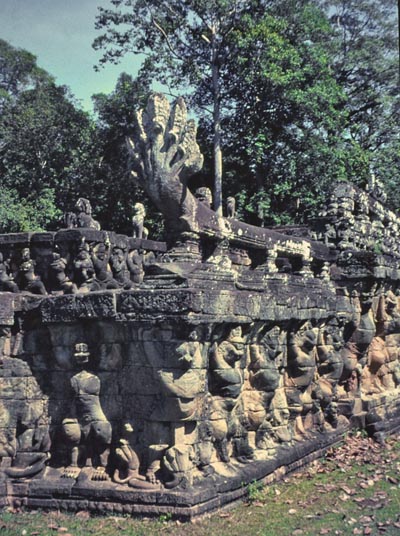
Nagas spread their cobra hoods as they rise up from the balustrades that line the tank at Banteay Kdei or the Sras Srang – the Royal Pool. Yet other nagas lie beside the causeway that leads to the temple of Angkor Wat, or encircle the inner courtyard at the temple known as Banteay Samre. Often they are found framing a scene from an epic story; at Banteay Srei for example, is depicted the story told in the Hindu epic, the Ramayama, of the struggle between Surgriva, King of the Apes, and his dispossessed brother Valin.
Of the seven keys, it was the naga that intrigued me most. My own subjective feelings of revulsion and morbid fascination where snakes are concerned were hardly helpful in trying to understand the symbolism of the snake. Both emotions certainly excluded any other thoughts when I ran across this python on a jungle road. What can be observed if emotions are put aside? First, the S-shaped manner in which the snake moves is distinctive. Its head moves in a straight line while the rest of its body oscillates from side to side. The flow of energy and movement in life is like an alternating current, now negative, now positive. The snake embodies this movement and, as such, is the perfect symbol for the vital energy of life, twofold but one. Through its ability to slough its skin, the snake also symbolizes the process of death and rebirth in man's spiritual life. Whether at rest or in movement, the snake is unobtrusive and blends with its surroundings. It goes unobserved unless disturbed. In this, too, it reflects the manifestations of energy.
Above all, the snake signifies attachment to the earth and represents the dark, chaotic forces of life. The snake is bound to earth by nature. But, as king of the nagas, the cobra is unique, for it is able to raise the upper part of its body towards heaven, a gift for which it must repeatedly prostrate itself. So too is man able to detach himself for short periods from his habitual state of blind involvement in the things of earth.
Many other ancient cultures have recognized the cobra as an unusual and majestic creature; in Thailand it graces the prow of the royal barges, while in Egypt it adorned the brows of the Pharaohs as the uraeus; and the cobra Muchalinda, the naga king, is said to have protected Buddha with his hood from the elements while he meditated beneath the Bodhi Tree.
So the snake has a twofold significance, it embodies the vital energy of life and it represents the dark forces of earth, the forces of chaos in life. It is the snake in me that represents the inertia that would deny me the wish to find a meaning to life. When I would seek the Tree of Inner Unity, the snake is there to offer me the tempting apples of multiplicity. As the symbol of earth, the naga-serpent presides over the earthly Angkor.
THE BIRD - THE SECOND KEY
In contrast to the denying forces of earth and darkness portrayed by the serpent, the bird represents the affirming principle of light, the wish to rise above the chaos of life to find inner unity and a meaning to life. As master of the heavens, the bird is the natural opponent of the serpent. In Hindu mythology the naga’s adversary is a griffon-like lord of the sky called the Garuda, a word derived from the Sanskrit root gri, meaning "to swallow." To give emphasis to his role, the Garuda is also called nagantaka, or "he who kills serpents," and nagasana, "he who devours serpents."
At Angkor the sturdy Garuda is portrayed in caryatid rows bearing a large terrace, upon which was built the wooden palace of the Devaraja, the God-King of Angkor. This great terrace lies in the center of the holy city of Angkor Thom. The Garuda can be said to be supporting or carrying the person and the palace of the God-King. In both Hindu and Middle Eastern iconography certain animals were associated with a particular god or manifestation of the Divine Principle. These animals were called the “vehicle” or vahana of the god since they appear to carry or support him. The vahana might be thought of as a duplicate representation of that aspect of the Divine Principle embodied by the god. The vahana emphasizes the god's role, as Destroyer rather than Creator for instance. The Garuda is seen here as the vahana, the vehicle of the Supreme God, Vishnu, whose earthly representative was the Devaraja of Angkor.
Before this Universe was given form by the divine fiat lux, formless primary matter, prakriti, was contained unmanifested in Vishnu, the Creator. All was One. With creation, this matter assumed form and the One appeared as many, as comprised of opposites, of heaven and earth, day and night, man and woman and so on.
To those who seek to understand the nature of this world and the meaning of life, Vishnu teaches that the secret lies in the identity of opposites. Indeed, one of Vishnu’s titles is “Teacher of Opposites.” For this reason, the Garuda is also shown as carrying the naga, its mortal enemy, on his back. In the presence of Vishnu, the opposing principles of life as represented by the snake and the bird are One. Neither the serpent nor the bird can ever vanquish the other without a dissolution of the Universe. At the same time, the duality of the phenomenal world is the product only of our senses, an illusion and not reality. Duality results from viewing life as comprised of opposites; but if opposites are seen as being complementary, then it is possible to glimpse the unity of all creation. What is required to see this is a different attitude.
THE FIVE TOWERS THE THIRD KEY
The duality of the phenomenal world is the product of the means by which an individual, come in contact with the manifested world. This contact is made with the five senses. The One Reality is perceived as Two through the intermediary of the five senses. So, in the Upanishads it is written: “A person is fivefold. This whole world, whatever there is, is fivefold. He obtains the whole world who knows this.” Reality becomes Illusion or Appearance as it passes through the Five Gates of Perception. He who knows this in practice can glimpse the Real Nature of the World. 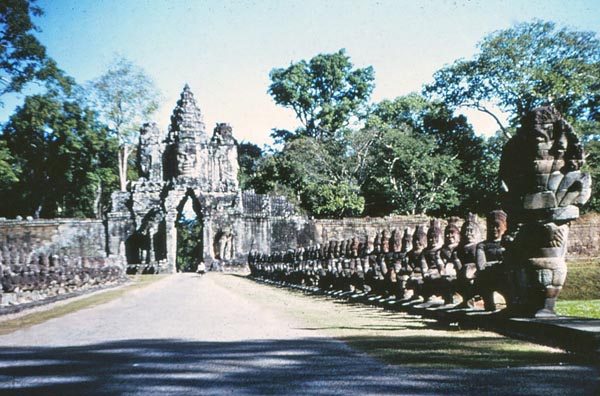
My inner world comes in contact with the outer world through the five gates or doors of my senses. In the Hindu tradition these doors are held to be sight, hearing, speech and touch, coordinated and interpreted by the mind.
The fivefold nature of perception is repeatedly echoed in temple architecture at Angkor as at the small 10th century temple of Prasat Kravanh, dedicated to Vishnu, or in the five towers of Preah Pithu in the city of Angkor Thorn. And five gates govern entry to Angkor Thom across five bridges.
Both gates and towers are similar in that they are points of passage, gates allowing movement on a horizontal plane, towers in a vertical plane. The towers are links between the duality of heaven and earth, the bird and the serpent, the spirit and the flesh, while the gates permit movement between the World of the Many and the World of the One. Symbolically, the One is to be sought in the center of the body, which is the Temple of Man.
The tower of the mind is central to and stands above the four smaller towers of the senses, which rise at the four cardinal points. The five towers of Angkor are the most perfect expression of the symbol. They are surrounded by miles of galleries. The first floor gallery alone is decorated with an uninterrupted frieze of bas-reliefs, six feet high and a mile in length. These carvings are a visual rendering of everyday life in the phenomenal world, the world of appearances as perceived through the five towers of the senses.
THE STEPPED PYRAMID - THE FOURTH KEY
The Khmer temple with its crown of five towers, is often built in the form of a stepped pyramid, representing the sacred Mount Meru, the link between heaven and earth. Indeed, the temple is often referred to as a temple-mountain. The symbolism of the sacred mountain is complex, but the aspect that appears most meaningful in this context derives from the pyramid.
The pyramid is a solid representation of the triangle which graphically conveys the coexistence of duality on the lower plane of earth, the sense-world, and the unity of the higher plane, heaven. As the Two emerges from the One through the Five Towers of the Senses, so the Two is reunited with the One. This is one aspect of the Law of Three. The pyramid is a three-dimensional symbol of this natural law.
Altogether nine pyramids were built at Angkor as microcosmic renderings of Mount Meru. The first of these was actually built on the only small hill to be found in the immediate vicinity of the Tonle Sap, the great lake that provided water for the extensive irrigation system upon which the agricultural wealth of Angkor was based. The temple was called Phnom Bakheng, the word phnom meaning mountain. The Kulen mountains can be faintly made out in the far distance. It was there that the Khmers quarried the sandstone used to build the temples of Angkor. Eight centuries ago, an estimated 750,000 people lived here from the produce of paddy fields and fish ponds. Today, the five towers of Angkor Wat rise above the surrounding jungle as the only reminder of the kingdom's former grandeur to be seen from this vantage point.
Angkor Wat, which is probably the best known of the Khmer temple-mountains, was one of the last to be built at Angkor. One of the most beautiful features of this temple is the great outer moat, 200 yards wide which forms a rectangle 1,700 by 1,500 yards. This view of Angkor Wat across the calm expanse of the moat is a visitor's first contact with this great city. 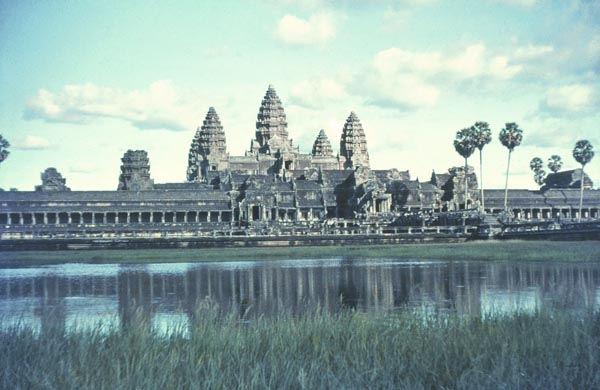
At the summit of the temple-mountain there stood the garbha-griha or “womb-house.” In sanctuaries such as that of Angkor Wat was performed the ritual marriage of opposites. This was the hieros gamos, the sacred marriage of Heaven and Earth, in which a woman who embodied the spirit of the serpent, Earth, and the Deva-raja that of Heaven, came together as one flesh in the garbha griha. In a passage describing the sacred nature of the union of man and woman, which is found in the Brihad-Aranyaka Upanishad, the husband exclaims: “I am Heaven, thou art Earth!”
The ritual marriage performed at the apex of the pyramid symbolized the fundamental unity that lies behind the duality of the sense-world, as did the geometry of the temple itself. Chou Ta-kuan, a Chinese traveler who visited Angkor in 1296, described this ceremony as taking place every night at the Phimeanakas or “aerial palace” in the center of Angkor Thom. “In the tower there dwells the spirit of a nine-headed serpent, who is master of the soil of the whole kingdom. It appears every night in the form of a woman. If one night the spirit of this serpent does not appear, then the king's time has come to die. If the king falls to appear, even for a single night, some misfortune will befall the kingdom.” The Greek historian Herodotus, writing 1800 years before Chou-Ta-Kuan, used much the same words to describe the rituals then performed in the temple of Bel in Babylon and in the temple of Amon-Ra at Thebes in Egypt.
The central sanctuary of many of the temples of Angkor was also the repository of one of Hinduism's most important religious images, a stone lingam set in a yoni. The lingam is in the form of the male member which stands as a rounded pillar in the center of the yoni, fashioned in the shape of an incised cup or table to symbolize the female sex. Most have now been removed to the safety of the National Museum in Phnom Penh, but a row of lingams may still be seen at the temple of Banteay Srei. The lingam and the yoni portray the union of Shiva and his goddess-consort, Shakti, as the complementary forces of nature. Both death and birth become possible when, for a moment, the Two become One.
The geometry of the pyramid, the ritual of the sacred marriage and the symbol of the lingam and yoni are different aspects of the same key to understanding the life principle that Two are One in Three. While deceptively simple, the ability to apply this principle in life can only come through cultivating a new way of thinking. The Tower of the Mind that rises above the garbha-griha proclaims this message.
THE SEVEN STEPS - THE FIFTH KEY
While the temple-mountain portrays the link between Heaven and Earth, the One and the Many, it is also conceived as a representation of the steps or stages through which the Seeker for Truth must pass on the inner journey from chaos to unity. Built as a stepped pyramid, the temple symbolized this progression, of which a good example may be seen in the small, well-preserved temple of Baksei Chamkrong, which stands outside one of the five gates of Angkor Thom. Including the ground level and the lotus-topped summit, the stepped pyramid comprises seven levels.
Yajnavalkya, the great teacher of the Upanishads, was once pressed to state the real number of Gods in the Universe. In response to repeated questioning, the sage gradually reduced the number of Gods in seven steps from 3,306 to One (Brihad-Aranyaka, 3.9. 1-9). These Gods can be understood as representing the influences and laws to which the phenomenal world is subject.
At the first stage, ground level, the number of outside forces that command man’s everyday life are seemingly overwhelming, impeding any attempt to search for reality in life. But it is possible, given the wish. As the Seeker struggles up the steep and narrow path, so his existence becomes, at each higher level, progressively less conditioned by the outside world. As he continues upwards, he comes closer to realizing the spiritual aim of “being in the world, but not of it.” Yet, without denying the physical fact of his existence, no mortal man can aspire to reach the highest level, the Seventh Heaven, for no steps lead to the lotus at the summit. Other temples that clearly resemble the classic form of the stepped pyramid are Ta Keo and the Baphuon.
The seven stages on the evolutionary journey through this world echo the seven worlds of the creation. Each higher world can be thought of as containing all the lower worlds, according to the principle that “as above, so below.” Thus, the three-dimensional world in which man exists contains the worlds of one and two dimensions and is itself contained in a four-dimensional world. Man can have intuitive knowledge of the world immediately below his own as well as the world immediately above. 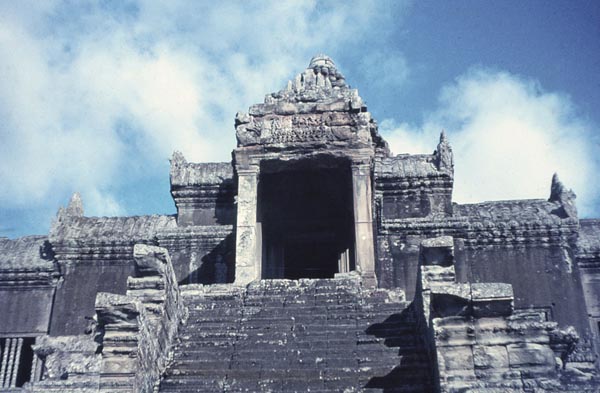
At Angkor, as also in Babylon and in Indonesia at Borobodur, this teaching concerning man's place in creation was sometimes communicated by a series of bas-reliefs representing the world below, which were either buried, as at the Bayon, or hidden from view by a blank wall. The Terrace of the Leper King is an example of this last practice. Thus, the stepped pyramid above ground symbolizes man's aspiration to another, higher world, while the portion below ground recalls the existence of the underworld.
THE WORLD AXIS - THE SIXTH KEY
The world of Angkor was at different times centered in whatever temple was chosen or built by the reigning God King. A stele found in Angkor had these words inscribed upon it: “Because the center of the Universe was marked by Mount Meru, he thought it fitting to have a Meru in the center of his capital.”
For the Khmers, Angkor was the hub around which their world, on the plane of earth, revolved. At the same time, their world was the reflection of a higher reality based on the principle that “whatever is below is like that which is above.” The temple-mountain was therefore situated below the center of heaven, or the higher world. The line linking the center of heaven, earth and the underworld was the “world axis.” In other traditions, this axis was also referred to as the great world tree or as a ladder. 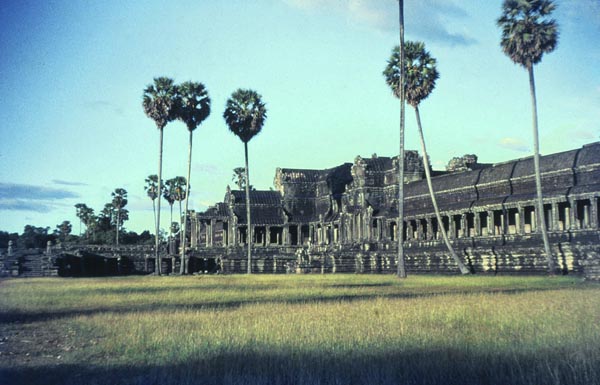
At Angkor, the temple-mountain, fashioned in the image of Mount Meru, was situated in the line of the world axis. This axis runs vertically through the central tower of the temple linking the seven worlds. The garbha griha or central sanctuary is the earthly hub around which time and space revolve. Examples of the axis mundi in neighboring countries convey this idea even more dramatically, as in the case of the Temple of Dawn in Bangkok and of the Qutub Minar in New Delhi. A thousand year old iron pillar, which now stands in the courtyard of the Qutub Minar mosque, formerly marked the world axis in an unknown Hindu temple, before eventually being brought to Delhi by the Moguls.
In Arabic, the word Qutub means the magnetic pole, pivot, polestar or chief. Using the Abjad system of letter number encipherment, the word Qutub can be transposed into the number 111, the threefold unity. When this number is recoded by digits, tens and hundreds, the letters QYA are obtained, meaning “to be vacant, voided.” So, apart from its cosmological connotations, the world axis also posits the existence of a psychological space, a central point in man in which freedom and balance may be experienced.
THE CHURNING OF THE SEA OF MILK- THE SEVENTH KEY
The Search for Inner Unity is the hidden meaning of the message conveyed by the holy city of Angkor. The seventh key to this search is to be sought where all may see it, before the five great gates of Angkor Thom and in the Prea-sat Neac Pon, the Tower of the Intertwined Dragons. The bridges of Angkor Thom and the tower of Neac Pon are representations of the Hindu legend of the “Churning of the Sea of Milk.” The seventh key links the previous six together as a living whole.
The manner in which this legend is portrayed at Angkor differs from that of the other keys in two ways. First, it conveys a real feeling of movement, whereas the first six keys appear as more static or unchanging expressions of the laws of the inner life. Second, it also states the most secret in the most obvious. It is the only key which illustrates a colorful and popular story showing unequivocally how the key is to be used.
In this myth can be recognized one of man’s most ubiquitous and perennial spiritual symbols known in different cultures as the caduceus, the staff of Thoth, of Hermes, of Mercury, of Moses and as the yin-yang of the Tao. The use of the staff as a churn-stick is to be seen in the Egyptian symbol of the Uniting of the Two Lands of Upper and Lower Egypt and in the legend of Quetzalcoatl, the feathered serpent of the Aztecs of Mexico.
So basic a symbol was the caduceus, that it has been repeatedly used throughout the world to express the dynamics of man’s search for inner unity. Like so many elements of the Teaching, those responsible for transmitting the necessary practical knowledge ensured the survival of key symbols by incorporating them in popular legends and iconography that would be treasured for all time.
In recounting this story now, one can do no more than hint at its real message by recounting what one has understood it to mean. However satisfying it may be to find an “answer,” it must be remembered that the questions raised by a legend such as the “Churning of the Sea of Milk” must remain even more important.
The Person is a house in which dwell many gods and devils, the forces of Light and Darkness. The Person is many, not One. All is confusion. Positive and negative forces, feeding on the senses, alternately dominate the house in which they live. Although the Person is nominally the Master of the House, he has in fact no control over the gods and devils. His authority as Master is usurped by whichever is the dominant force at a given moment. The Person is as though asleep to his real nature which is to be the Master of his own life. And yet there are moments when he feels that all is not right, when he feels that were he to awaken to his real nature, he would be able to find meaning to life where all is now chaos.
Indra, Lord of the Gods in the Person, was aware of this feeling and this wish. If this wish could be fulfilled, Indra hoped that the gods united could achieve mastery over the devils. Thus it was that Indra, acting in the name of the Person, took it upon himself to seek outside help in attaining this goal.
First, Indra approached the Creator himself, Brahma, who, with Vishnu the Maintainer and Shiva the Destroyer, comprises the great Trinity of Higher Forces in the Universe. Brahma was sympathetic to Indra's request for help and directed him to ask advice of Vishnu, who, as Lord of Maya, the Power of Illusion, is also the Teacher of Opposites. Vishnu dwells deep in the waters of illusion, the Sea of Milk. From him Indra learnt that the search for the Person’s real nature was none other than the quest for the Elixir of Immortality, Amrita. The search would involve long and arduous work and could not be undertaken by the gods alone. In fact, they would need the help of the devils to accomplish the task. Of course, the natural cupidity of the devils would guarantee their full cooperation.
In reply to Indra’s query as to where the Elixir was to be sought, Vishnu motioned to the all-engulfing Sea of Milk. The Elixir of Life, he indicated, lay at the bottom of this Sea, none other than the sameness of everyday life. By intentionally churning this Sea, the Elixir would in time, and in the right conditions, reveal itself to the Seekers, the gods and devils within the Person. The churning stick was to be Mount Meru, the central axis or feeling of “I” of the Person. Vasuki, the great serpent of the Person's earthly nature, would serve as the means of churning Mount Meru. The movement of the churning waters of life would help the Person develop the sensation of a stable center within himself from which he could observe the alternating motion of the gods and devils and see them as manifestations of the energy of life. The Person might then observe that the nature of the energy at work in his inner world was identical to that of the outer world. And so it was agreed by both Gods and Devils that they should jointly embark on the task that Vishnu had proposed to Indra, namely that they should churn the Sea of Milk for the Elixir of Life.
The Person’s gods and devils made ready to commence the work of churning and, without further thought, the gods moved to the serpent’s head, while the devils found themselves at its tail. But when they had taken their places, the devils protested loudly that they were being insulted and demanded that they be allowed instead to hold Vasuki’s head. When Indra took pains to remind the gods of the importance of the work, and of the need to put vanity and self-pride aside, they eventually agreed to change places with the devils and to take the tail.
No sooner had the churning commenced than it became apparent that the sensation of “I” was not firmly centered in the Person, and the churn-stick slid back into the sameness of the waters. Vishnu, Teacher of Opposites, saved the situation, however, by showing with his own being where the stable center could be found in the movement of life. He turned himself into a sea-turtle and offered himself as the pivot for the churn-stick. 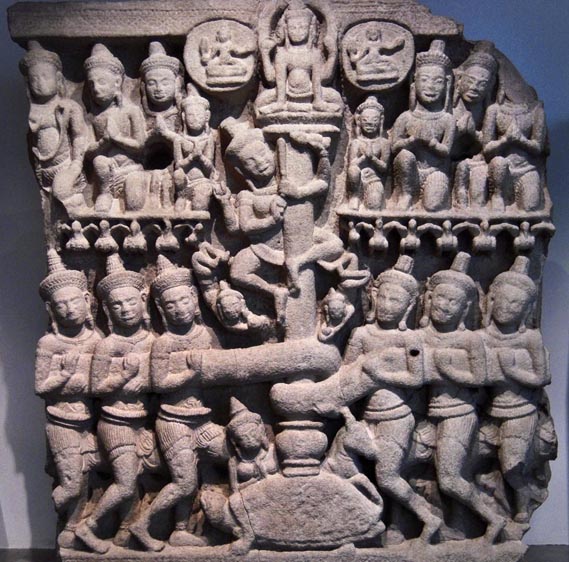
So the work began anew and countless were the times it proved necessary to recenter the sensation of “I.” But then, slowly, like a newborn child learning to see, the “I” of the Person began to observe the gods and devils, who, as in some great tug-of-war, pulled now this way, now that in response to life. What the “I” observed was the Person as he really was. For the first time he was able to see clearly the horrifying appearance of the devils. Indeed it was such a sickening sight that the Person was touched to his innermost being. Vasuki, the Person’s earthly nature, was so affected by what the Person saw that vomit began to rise slowly along the length of his body. Shiva, the Destroyer, had meanwhile been quietly looking on, and he knew full well that should the Person’s inner sickness gush forth upon the outer world, it would engulf and destroy all it fell upon. Fearful of the danger, Shiva stepped forward and swallowed Vasuki's poisonous vomit as it gushed from the serpent’s jaws; so virulent was the poison that it left a blue burn mark on Shiva’s throat. Even today, many devotees of Shiva carry a blue mark on their throats as a reminder of the need for their inner sickness to be neutralized by a higher force lest it destroy all around them.
As the work continued for many years, so the gods and devils came gradually to accept each other and to move in unison. At last, the first of many wonderful signs began to appear in the churning turmoil of life. First, there materialized the marvelous wish-fulfilling tree of paradise, Kalpa vriksa, an indication that the wish of the Person would be granted.
Next Airavata, the elephant vahana of Indra, was seen standing majestic amidst the churning waters, as he stands today before the gates of Angkor Thom and at Pre Rup. The name of Airavata is also given to Indra's weapons, the lightning bolt and the rainbow, signs that understanding accompanying inner unity would strike at any time, all-encompassing and all-illuminating.
Then emerged a great lotus, upon which stood Sri Lakshmi, the Lotus Goddess. The lotus was the first product of the creative principle; it was perfect and incorruptible. As the symbol of the creation, the lotus carried the symbol of the wisdom that transcends the duality of the sense-world, the image of the Goddess, for Lakshmi as Prajna-Paramita, is the “Enlightening Wisdom (prajna) now gone to and abiding upon (ita) the Other Shore (para).”
Beautiful Apsaras, the courtesans of the sky, were seen dancing upon the waters, protected by their jealous consorts, the fierce Gandharvas. In effect, the closer the Person comes to fulfilling his aim, the more he stands to lose from being enchanted by the Apsaras, those temporary attractions of the senses. The Apsaras raise the continual question of what is important in life, while the Gandharvas' drawn swords serve as reminders of the fate that awaits the weak.
The goal of the Work in Life, Inner Unity and Truth, finally appeared in the form of the black-faced physician of the Celestials, bearing the Cup containing the Elixir of Life. The physician is one who makes the sick whole. In finding wholeness, that is, unity of being, the Seeker tastes the sweet Elixir of his True Essence, so long hidden in the troubled waters of the Sea of Life. The rebirth of True Essence in the Cup of Life at the same time spells the death of False Personality, hence the black face of the Cup-bearer.
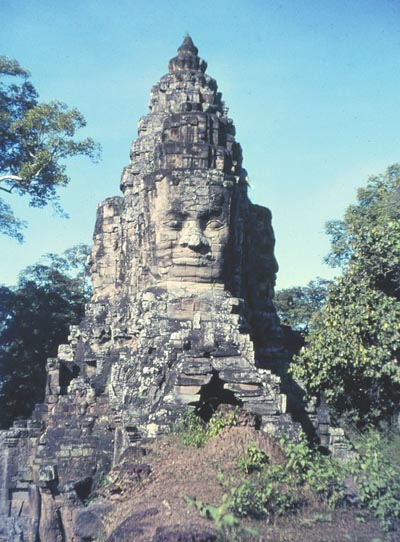
EPILOGUE
Angkor is therefore much more than a romantic lost city in the jungle. Indeed, it could be more aptly called a “Pilgrim's Progress” in stone, for it is in a sense a book that describes man's search for what is real, for light and for something in man that will not die with this earthly body. The Book of Angkor contains the keys necessary to open the doors that are to be encountered in this progress through life. Above all, Angkor teaches that the object of the search is not to be sought in the outside world but in the inner temple of man.
The Sufi poet, Rumi, wrote: “Cross and Christians, end to end, I examined, but He was not on the Cross. I went to the Hindu temple and to the ancient pagoda, and in neither was there any sign. I went to the heights of Herat and to Kandahar. I looked, but He was not to be seen on hill or valley. Resolutely I climbed to the top of the Mountain of Qaf, but I found only the nest of the Anqa bird. I knelt at the Kaaba and saw Him not … Then I looked into my own heart. There I saw Him, for He was in no other place.”
SUBSCRIBE NOW
TO OUR MONTHLY NEWSLETTER









Share Your Comments and Reflections on this Conversation:
On Dec 16, 2023 Daryle Judie wrote:
I think it was great infomation and very interesting Thank youOn Nov 21, 2022 Lindsay Kelly wrote:
This is one of the most beautiful pieces of writing I have come across. Thank you.